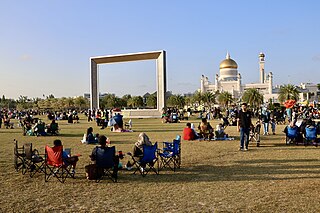
Brunei–Muara District or simply known as Brunei–Muara, is the smallest as well as the most populated district in Brunei. It has an area of 571 square kilometres (220 sq mi) and the population of 318,530 as of 2021. The district is also home to its administrative centre is Bandar Seri Begawan, as well as the Brunei International Airport and Muara Port, the country's only international airport and deep-water port respectively. The Brunei River flows within this district and is home to Kampong Ayer. As the administrative center of Brunei is located in the district, it remains the most developed in the country with the most up-to-date infrastructure, despite not being the center of Brunei's main economic activity.

Muara or officially known as Muara Town, is a port town in Brunei-Muara District, Brunei, about 28 kilometres (17 mi) from the capital Bandar Seri Begawan. The population of the town proper was 2,102 in 2016. It is home to Muara Port, the country's primary deep water port.
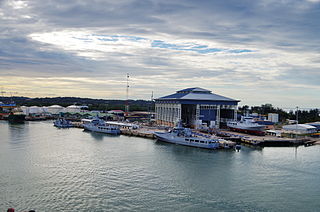
Mukim Serasa is a mukim in Brunei-Muara District, Brunei. The population was 16,173 in 2016. The mukim encompasses Muara Town, home to Muara Port, the country's only deepwater port.
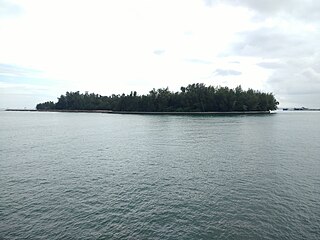
Pelumpong Spit is the easternmost point in the Brunei-Muara district of Brunei. Despite its name being labeled as a spit, it is now an island due to the artificially constructed 50m-wide, 10m-deep Muara cut, which separated the spit from the mainland to provide access to Muara Port.

Mukim Mentiri is a mukim in Brunei-Muara District, Brunei. The population was 30,192 in 2016.

Mukim Kota Batu is a mukim in Brunei-Muara District, Brunei. The population was 12,935 in 2016. The mukim is home to some of the country's museums and historical sites, in particular in Kota Batu.

Kampong Serasa is a village in Brunei-Muara District, Brunei, near the port town Muara. The population was 3,200 in 2016. It is home to Serasa Ferry Terminal, the country's primary international ferry terminal.

Sultan Haji Omar 'Ali Saifuddien Bridge, also known as Temburong Bridge, is a dual-carriageway bridge in Brunei that spans across Brunei Bay, connecting the Bruneian mainland with its semi-exclave of Temburong District. It is the longest bridge in Southeast Asia, at 30 kilometres (19 mi) long.
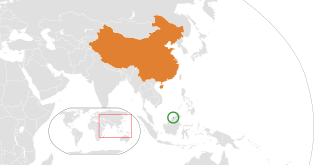
Brunei and China established formal diplomatic relations in 1991. Brunei has an embassy in Beijing, and China has an embassy in Bandar Seri Begawan.

Transport in Brunei consists of air, land, and sea transport. Previously there was some rail transport in Brunei, but eventually most of it was closed down. Several public and commercial sector organizations are in charge of creating and overseeing these networks and infrastructures. The Ministry of Transport and Infocommunications (MTIC) is in charge of overseeing the maritime and aviation industries, as well as planning and regulating all kinds of land transportation.

Progresif Sdn. Bhd. is a Brunei-based Government Linked Company headquartered in Bandar Seri Begawan, Brunei. Founded in 2014, Progresif now has more than 130 employees and around 200,000 customers, with eight retail stores throughout the kingdom.
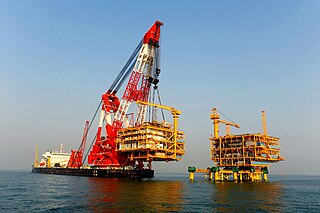
Lanjing (蓝鲸) is a self-propelled, deep water crane vessel, owned by China National Offshore Oil Corporation (CNOOC), the national oil exploration company of China, through its Hong Kong-listed subsidiary CNOOC Limited. Built in 2012, it is one of the six large crane barges owned by COOEC and CNOOC, namely HYSY201, HYSY 202, Lanjing, Blue Xinjiang, Binhai 109, HYSY286, HYSY289 and HYSY291.
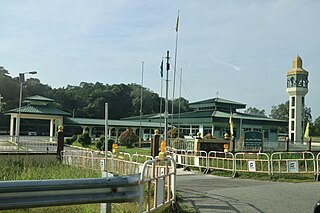
Kampong Sungai Besar or commonly known as Sungai Besar, is a village in the east of Brunei-Muara District, Brunei, near the mouth of the Brunei River with the Brunei Bay. The population was 2,039 in 2016.

Muara Besar Island is an island in Mukim Serasa, Brunei–Muara District, Brunei. The island is essential for the Brunei–China relations due to its part in the Chinese Belt and Road Initiative. It can be noted that the island may be referred to Muara Island in older works.

The Muara Port, also known as Muara Harbour, is a seaport operated by the Muara Port Company (MPC) Sdn Bhd, under the supervision of the Maritime and Port Authority of Brunei Darussalam. The port also contributed to the Brunei Darussalam–Indonesia–Malaysia–Philippines East ASEAN Growth Area (BIMP-EAGA).
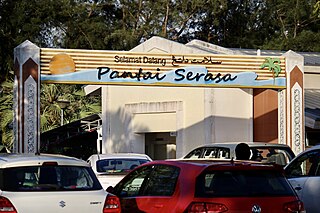
Serasa Beach is a 1.5 km long artificial split off the Serasa Bay, Mukim Serasa, Brunei-Muara District, Brunei. The beach also lies a few minutes from Muara port and town.

The Serasa Ferry Terminal, also known as Serasa Muara Terminal and Serasa Terminal, is a passenger terminal operated by the Department of Immigration and National Registration in Mukim Serasa, Brunei-Muara District, Brunei. It is one of the two ferry terminals in Brunei, which is located in Kuala Belait Port and Serasa.

The Brunei Fertilizer Industries (BFI) is a government owned company and producer of ammonia and urea granular fertilizer, located in Sungai Liang Industrial Park (SPARK), Belait District, Brunei. It is claimed to be one of the largest fertilizer facilities in Southeast Asia, and has a production capacity of 1,365,000 tonnes of urea annually. The facility for BFI started being built in May 2018 and 500 jobs were expected be created when the plant was fully operating.
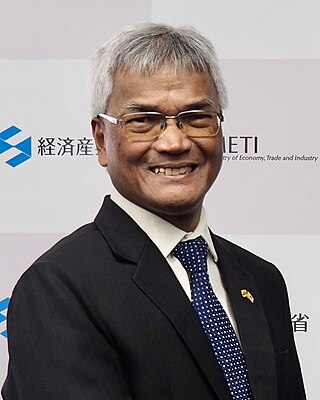
Matsatejo bin Sokiaw is a retired Bruneian politician who was the Deputy Minister of Energy from 2018 to 2023. Notably, he is also the managing director and CEO of the Brunei National Petroleum Company (PetroleumBRUNEI), the deputy chairman of the Authority for Info-communications Technology Industry (AITI), and the director of Darussalam Assets (DA).



















